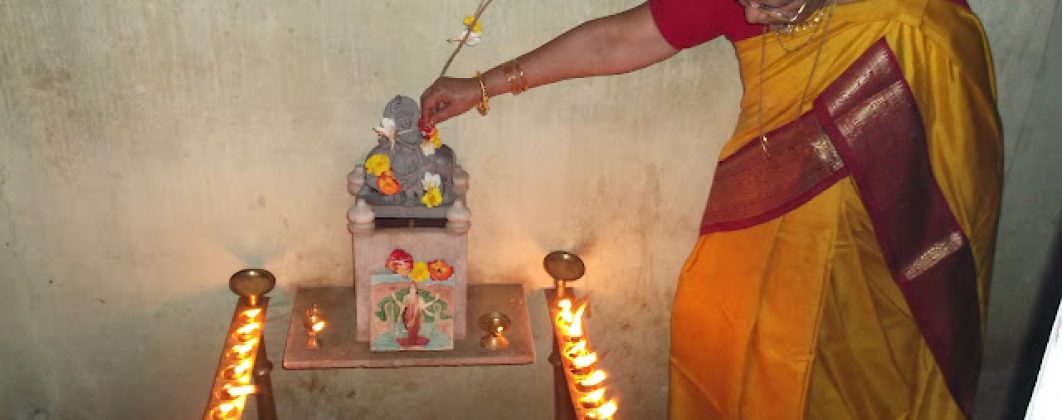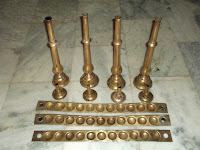
 |
| Tulsi Pooja with special Diya arrangement from YK’s Collection |
Light is life.Without light there is no life on earth. Hence any source of light is considered as divine in Hinduism. Sun is a god known as Surya Bhagavan and moon is a demi god known as Somadeva. All man made sources of light like, oil diyas are sacred objects and are used in temples, prayer rooms and religious ceremonies. At the time of pooja (prayers) along with offerings to god like flowers,fruits,special food items,water,light from oil diya is also given as an offering to god. We can say that Hinduism is a religion of lights and fire. You can not think of a religious ceremony or ritual celebration without the traditional oil lamp. There is a dedicated festival for celebration of lights known as Deepawali. Artisans started preparing a special variety of lamps for special poojas, thus bringing in art, festivity and the spirit of celebration into a religious ritual. Here is an unique oil Diya set specially made for Tulsi Pooja also known as Ksheerabdi Dwadasi Pooja.
 |
 |
Tulsi Pooja Diyas
Tulsi Pooja diyas arrangement shown in this picture is exclusively made for Tulsi pooja. Almost all Hindu houses will have a Tulsi plant in their house. Those who live in cities in an apartment will have a pot in the balcony with a small Tulsi plant in the pot. Those who stay in individual houses will have special structure called Tulsi kota (known as altar which means castle for Tulsi) on the ground in which soil is filled and a Tulsi plant is planted. This light arrangement is made to have lighting in three sides of the Tulsi kota that is front side, left side and right side of the Tulsi kota.
According to Hindu faith, Tulsi plant is considered as an incarnation of Goddess Laksmi in the form of a plant and hence Tulsi plant is a very holy plant and the ladies in the house do pooja for Tulsi plant every day by lighting a lamp,pouring some water to the plant and do pradashin(going around the Tulsi Kota 3 times).Yearly once they do a special and elaborate pooja on the day known as Ksheerabdi Dwadasi which falls according to Hindu calendar on the 12th day during the Shukla Paksha (waxing phase of moon) in Kartik Month (the month of November).
 |
| Tulsi Pooja Oil Diyas arrangement without lighting |
Lord Vishnu vowed that on Karthika Shukla Dwadasi, after sunset, He, along with Devi Lakshmi will rise from the Ocean of Milk (Pala Samudram), and reside in Tulsi Kota (Brindavanam). With him, will reside all gods and sages.
 |
| Tulsi plant in a Tulsi Kota |
On that day, anyone who comes to Brindavanam, does pooja wholeheartedly to Lakshmi, Tulsi and Shree Vishnu, read or listen to Tulsi’s story and give deepam danam will get rid of “all previous birth wrong doings, and wards off any ill luck and attain moksha (the Lord’s sanctity) forever. On that day the Tulsi kota is regarded as Brindavanam and the platform surrounding the Brindavanam is called Brindavan mantapam. Special lighting arrangements are made in Brindavanam and on Brindavan Mantapam for Tulsi pooja or Ksheerabdi Dwadasi pooja.
 |
| Tulsi Pooja – Krishna avataar of Vishnu and Lakshmi in Brindavanam |
It is stated in puranas that Lord Vishnu loves Amla (the Indian Gooseberry) and on that day they place a branch of Amla tree with Amla berries in the Brindavanam along with the Tulsi plant symbolizing that Vishnu and Lakshmi are together side by side.It is on the very same day of Ksheerabdi Dwadasi, Vishnu marries Lakshmi. On this day Lakshmi emerged from the ocean of milk when Devatas and Asuras churned the ocean of milk for getting Amrut, the nectar that gives eternal life. When Laksmi emerged from the milky ocean, Vishnu married her and the marriage took place on the same day. The other name for Lakshmi is Ksheerabdi (Ksheera-milk, abdi-emerged) meaning the one who emerged from the milk of the ocean. Thus this pooja is also known as Ksheerabdi Dwadasi Pooja.
 |
| Tulsi Pooja Oil Diyas showing individual parts |
Assembling the diya set
Tulsi diya system has to be arranged by joining three components:the pillars,the strip of diyas and the bolt with a big diya.The components are shown in the picture.
 |
| Tulsi Pooja Oil Diya showing the joining of pillar, strip of diyas and bolt with diya |
To ensure the right diya srip end sits on the right pillar end and the right bolt holds them together, all the assembling ends are numbered in the Devanagari numbers.This Devanagari numbering system also says the antiquity of the Diya set.
 |
| Tulsi Pooja Oil Diya showing Devanagari numbers on pillar, diya strip and bolt diya |
To interpret the significance of this pooja for the modern times, Tulsi is an herb (Ocinum Tenuiflorum) that has lot of medicinal properties that cures ailments related to cough,cold and any breathing related ailments.Indian Gooseberry (Phyllanthus Emblica) is full of Vitamin-C and it also cures all ailments related to the winter season. Ksheerabdi dwadasi falls in a period that rainy season ends and winter season starts. Thus doing this pooja for Tulsi and Indian Gooseberry plant on this day and eating the leaves of Tulsi and Indian Gooseberries as a Prasad helps the person to prepare with stamina to face the onsetting winter.
For lighting the lamps cotton wicks are soaked in oil and to keep the flame burning oil is poured in the diya. On the Ksheerabdi Dwadasi Vratam day, cow ghee is used as it is considered as pious and holy.If cow ghee is not available, the next best alternate oil is sesame oil.
 |
| Wicks used (Puvvu Vathulu) for lighting Tulsi Pooja Oil Diyas |
Special wicks for Tulsi pooja diyas.
Diyas in this arrangement are round shaped and have no snout protruding. Hence we cannot keep the traditional kada vathulu(long thread like wicks).Instead special wicks called Puvvu Vathulu(resembling an inverted flower) are used.The wick will stand on its own when dipped in oil and placed on the diya.This wick is kept in the center of the diya cup and oil is poured to immerse the flower side of the wick. Only the stem side of the flower wick is lighted.
 |
| Single Puvvu Vathi positioned in the Diya |
How I acquired this Tulsi Pooja Oil Diyas ?
I got this diya set from a very authentic source. This Ksheerabdi Dwadasi oil lamps arrangement is gifted to me by my brother-in-law Vakkalanka Venkateswara Rao and his wife,my sister Suryakantham.This lamps arrangement is in their family since 5 generations.My brother in-law’s father Vakkalanka Krishnamurthy garu and their ancestors were in the service of the Maharaja of Pithapuram and they were in-charge of management of temples in Pithapuram.I was told by my syster that the family will take out this arrangement few days before Ksheerabdi Dwadasi, clean the whole arrangement and use it on the pooja day. After completing pooja the entire set is cleaned up, repacked and put in the family storage room.This is how the the lamp system is kept safe and handed over from generation to generation. Knowing my passion for antiques my brother–in –law and my sister have gifted this precious item to me.

Copyright © 2021 YK Antiques Home Museum
7 Responses
Mammayya I am very happy to see your antique collection posted on your blog. Looking forward to find more details of your antique collection.
Hari Pulugurtha, Troy, Michigan
Prathamanga Namaskaram,
to add this we also keep Charaku, Chintha pandu around tulasi tree. Do abhishekha to tulasi and damodara, do proper kanyadhanam.
I would like to know where can we get this lamp, I am keen to buy it. Is it available in Hyderabad/ andhra or Bangalore side? Let me know.
Savitha Gudipati
Dubai, UAE
Savitha garu, thanks for the additional information on Ksheerabdi Dwadasi pooja. I will add this information to my article. You are welcome to give your valuable suggestions for the other articles also.
I could not find this lamp in any other place so far. I move around a lot and I tried to locate a similar lamp since so many of well wishers like you ask for it. If I locate one, I will let you know. These are not manufactured now. We can only get them at antique shops.
very nice
namaskaram, I want this type of stand where do i get please inform
Hi where you get this lamp? Even I want purchase
Thank you for writing to us. We enquired in our known circles and also looked online but couldn’t find anything similar on sale. This particular tulsi pooja oil diya set was custom-made by the artisans that worked for the erstwhile Maharaja of Pithapuram and gifted to my brother-in-law’s father who was in the Maharaja’s court. My brother-in-law gifted it to me and that’s how it is part of the home museum now. If you wish to, you can have it custom-made by an artisan and refer to the one that we have as a model.